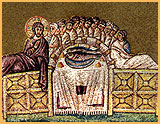|
Urban environment in the Early
Byzantine period
The most widespread Early Byzantine dwelling was
the independent  house, which, in an urban environment, formed one element
in a densely built-up block. Rich urban mansions abound in
the eastern provinces of the Empire. Antioch, Apamea, Palmyra,
Paphos, Athens, Argos, Carthage, Ravenna, Stobi, are among
the many cities where such extensive houses have survived.
These normaly feature a peristyle courtyard and a large reception
room
(Triclinium);
some have secondary salons and informal dining rooms, lavatories
and private baths. Decoration was opulent, with fountains,
sculptures, and mosaic or
opus sectile
floors and revetment. The reception/dining room (Triclinium)
was a rectangular hall often ending in a single
apse, inside
which was placed a semi-circular couch (stibadium or accubitum)
surrounding a semi-circular table (sigma table). The number
of apses increased according to the landlord's needs: triconque
triclinoi are fairly common. Urban palaces share the same
characteristics in a grander scale. They feature a number
of independent wings serving both private and public functions,
several courtyards, and grandiose reception rooms. The Triclinium
of the Lausus Palace at Constantinople had seven apses, and
the Great Palace Triclinium no less than nineteen.
house, which, in an urban environment, formed one element
in a densely built-up block. Rich urban mansions abound in
the eastern provinces of the Empire. Antioch, Apamea, Palmyra,
Paphos, Athens, Argos, Carthage, Ravenna, Stobi, are among
the many cities where such extensive houses have survived.
These normaly feature a peristyle courtyard and a large reception
room
(Triclinium);
some have secondary salons and informal dining rooms, lavatories
and private baths. Decoration was opulent, with fountains,
sculptures, and mosaic or
opus sectile
floors and revetment. The reception/dining room (Triclinium)
was a rectangular hall often ending in a single
apse, inside
which was placed a semi-circular couch (stibadium or accubitum)
surrounding a semi-circular table (sigma table). The number
of apses increased according to the landlord's needs: triconque
triclinoi are fairly common. Urban palaces share the same
characteristics in a grander scale. They feature a number
of independent wings serving both private and public functions,
several courtyards, and grandiose reception rooms. The Triclinium
of the Lausus Palace at Constantinople had seven apses, and
the Great Palace Triclinium no less than nineteen.
Another type of urban dwelling is the apartment building,
examples of which have been found at Ephesus, but this, too,
was reserved for the rich. Poorer dwellings are known in Anemurium,
Sardis, Philippi, Caricin Grad, and usually consist of rearranged
earlier structures. In the sixth century, large urban houses
were adapted to the increasingly rural needs by the addition
of kilns, wells and mangers
|